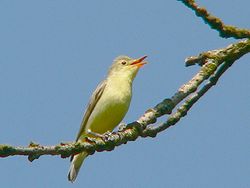| Hippolais | |
|---|---|
 | |
| Icterine warbler (Hippolais icterina) | |
| Scientific classification | |
| Kingdom: | Animalia |
| Phylum: | Chordata |
| Class: | Aves |
| Order: | Passeriformes |
| Family: | Acrocephalidae |
| Genus: | Hippolais von Baldenstein, 1827 |
| Type species | |
| Hippolais italica [1] Conrad, 1827 | |
Hippolais is a genus of tree warbler in the family Acrocephalidae. It is sometimes associated with the genus Iduna . [2] The genus name Hippolais is from Ancient Greek hupolais, as misspelt by Linnaeus. It referred to a small bird mentioned by Aristotle and others and may be onomatopoeic or derived from hupo,"under", and laas, "stone". [3]



